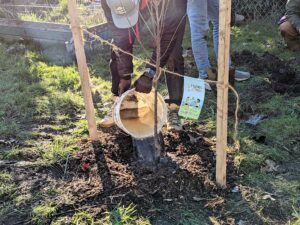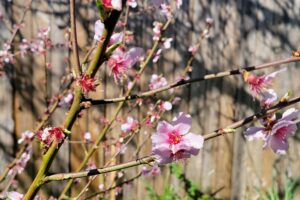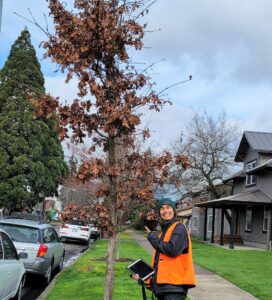Leaflet: Spring Tree Care
Spring has Sprung – What that means for your trees
Spring has truly come in fits and starts this year. Some of us might still feel like it’s winter, and some are ready to announce that Spring has sprung! Trees are the same way when it comes to breaking dormancy. Some are early risers, and some sleep in. A bunch of factors go into it, including species, daylight, and temperature.
Spring is the perfect time to notice seasonal cycles. The study of these periodic events in biological life cycles is called phenology. When does a tree go dormant, when do you start to see buds, how long is the growing season? We can see quite a range among species.
“Cornelian cherries normally bloom about this time of year,” says Neighborhood Trees Senior Specialist Andrew Land. “Whereas a few years back, someone approached me about an Oregon white oak that they thought was dead, until it finally broke bud in June.”
Andrew and other staff at Friends of Trees keep an eye on phenology as it particularly relates to survival. They take note of trends in trees’ responses to different stimuli like light and temperature, with the intent to prioritize the most climate adapted species.
Here are some things you can do to take care of your trees this time of year.
Mulch Madness
It’s a great time to refresh mulch as needed. The objective is to mulch the tips of the roots as they grow outward from the base of the trunk. They will grow into soil that’s moderate in temperature and contains moisture, factors that mulch will provide. Because the roots are growing outward, when you mulch trees in their second year in the ground, aim for more of a 4-5′ diameter ring of mulch, still 3” thick, about a foot from the base of the trunk.
You may have noticed that some trees hold their leaves through winter. They’re called marcescent leaves, and they are a sign of last season’s growth. You’ll see them on native oaks like Oregon white oak (Quercus garryana) and scarlet oaks (Quercus coccinea). Come spring time’s flush, these leaves will be shed to make room for new growth. You can use these leaves as mulch!
 Go easy on the pruning
Go easy on the pruning
It’s best to go easy with regard to pruning during “bud break.” This is when sap is rising up the tree, after having dropped to the roots in the fall. As the sap is rising, some trees (maples, for example) will “bleed” if pruned as sap is rising. It’s not harmful to the tree—that’s where maple syrup comes from, after all—but it can be disconcerting to see.

Weekly Watering
It’s almost time to start weekly watering for newly planted trees. “Deep and infrequent” is the recipe for success. Starting mid-April, 15 gallons all at once, once a week is ideal. Either a gator bag, hose on a gentle trickle for maybe 20 minutes, or a 5-gallon bucket with three 1/8″ holes drilled on the side at the bottom and filled 2-3 times consecutively works great.
If the temperature gets over 90 degrees, bump that up to twice a week. If we see another heat “event” coming, a good, deep soak beforehand is very wise as preventative medicine.


 Go easy on the pruning
Go easy on the pruning